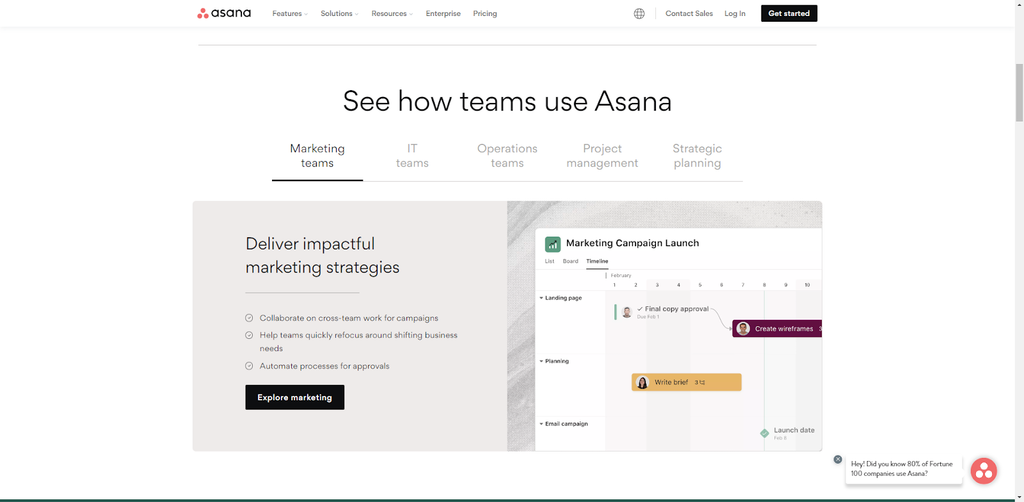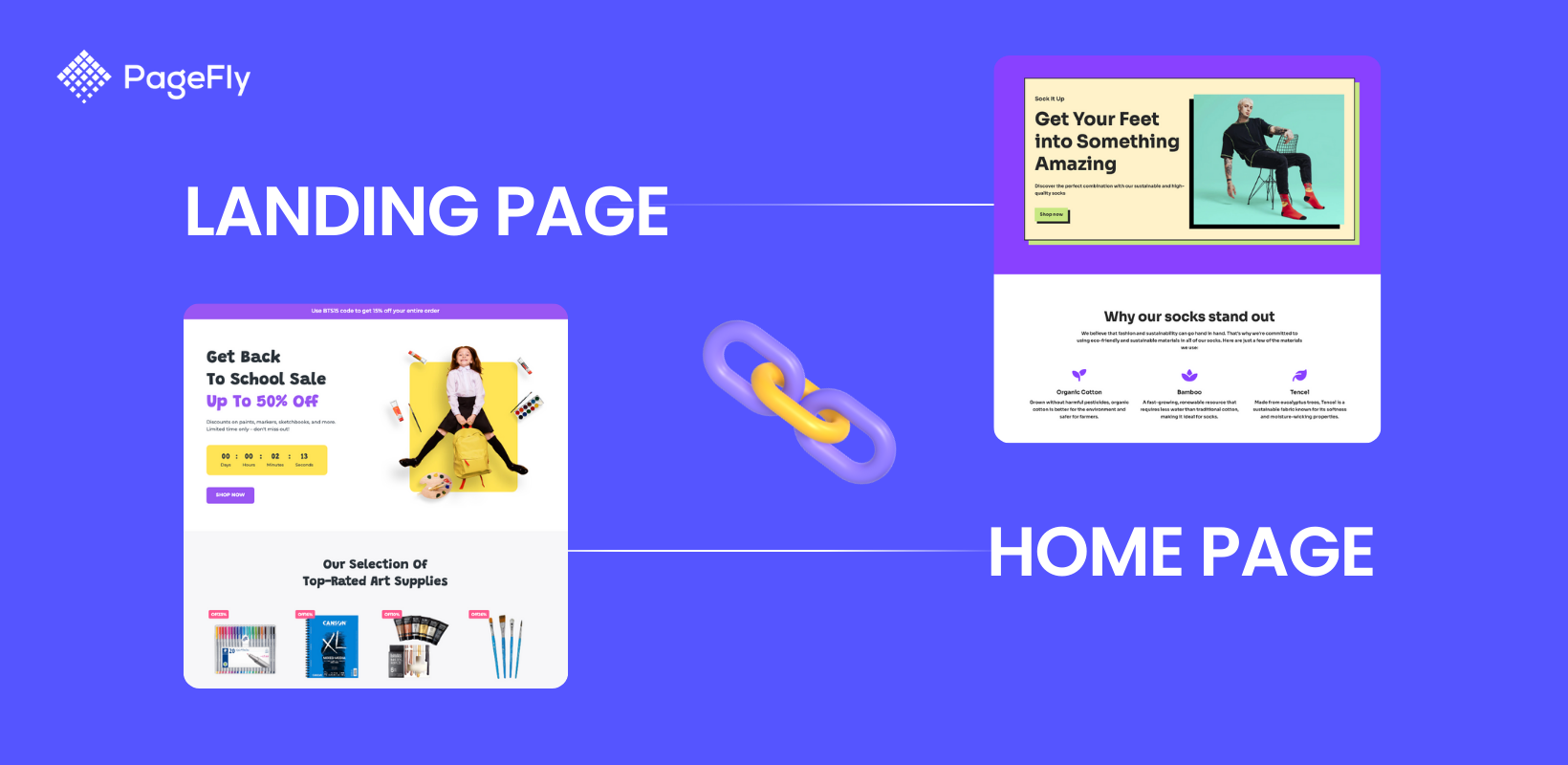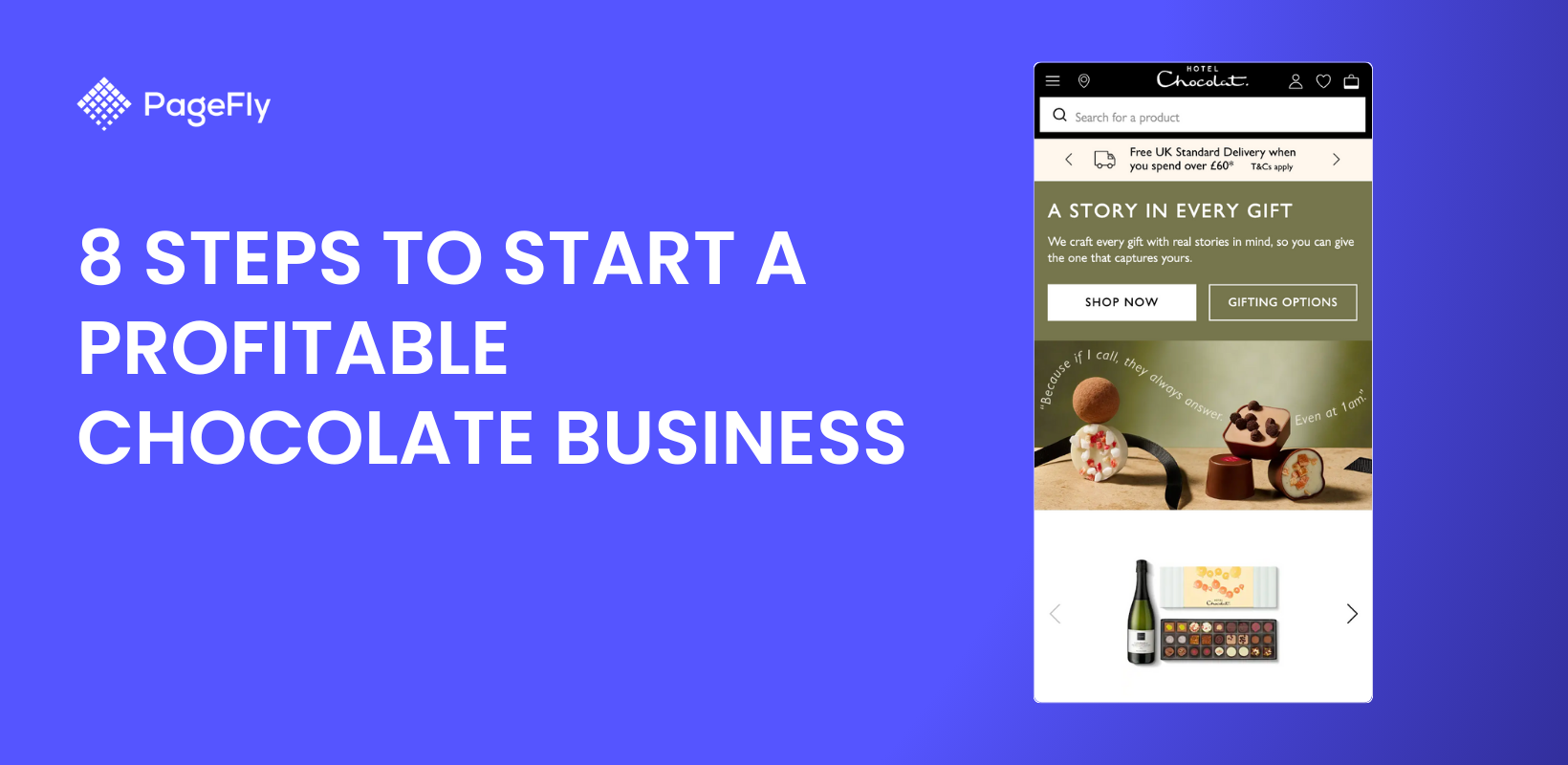Newcomers to the digital marketing sector frequently believe there is no distinction between a landing page vs homepage.
Everything depends on what they are intended for. Focus is the main distinction between a homepage and a landing page. In other words, you want to use them to accomplish various objectives.
Depending on where a customer is in the customer journey, ecommerce marketers are aware that it matters which page a customer ends up on.
You can make your store work harder for you once you recognize the difference.
We'll explain the main difference between landing page and home page in concrete terms. For you to use these ideas in your work with ease, practicality is crucial.

Definitions

Content
Landing page:
- Brand Introduction: It provides the client with more in-depth information by highlighting the core business details of the services provided and the firm's accomplishments.
- Trust Indicators: Online shoppers are wary shoppers. You need to establish trust right away because a landing page forces you to be as succinct as possible with your information. There are reviews and an external rating score in this example.
- The Offer: The heading, opening sentence, and call to action button all make it clear what the client is likely getting.
Visitors are directed to a post-click landing page from a paid traffic advertisement or a web search. To entice the user, these advertisements or links would make a very specific offer. The landing page goes on to explain this offer and what makes it appealing.
Homepage:
- Brand Introduction: You have a whole website’s worth of space listing core business details, so your brand introductions can be more detailed. Homepages are generally broken up into several sections.
- Trust Indicators: There will still be testimonials, ratings, and other trust indicators because they are still important. The distinction is that there is more room for inclusion. Businesses frequently switch between different testimonials in a banner slider. Links to recent awards and accomplishments in news stories are a great way to highlight your accomplishments without overwhelming the visitor.
- The Offer: Your offer for your landing page vs homepage will be vastly different. Your homepage will showcase all of your brand's offerings rather than just one particular one.


Purpose

Landing Page:
Your landing pages are accurate instruments. So what does a landing page serve as its primary function?
A landing page is designed to persuade visitors to carry out a specific action, like buying a subscription or downloading an ebook.
A landing page, as opposed to your homepage, is designed for a much smaller segment of your audience and can therefore use targeted language to increase conversion rates.
Therefore, in order to effectively convert lots of customers, you should develop a number of distinctive landing pages that target customers with various profiles. Targeted messaging will be used on each landing page to persuade visitors to click the CTA.
Also, you can make use of the PageFly app to solve the problem with building landing pages. PageFly is one of the most popular landing page builders. It allows you to design beautiful landing and product pages without any coding. And the best thing is, it offers a free plan. You can check out more than 100 professional templates which are designed for your sales campaigns, covering all niches and page types.

Source: PageFly.io
Landing pages focus on a targeted message because they can control who sees the page.
Landing pages, in contrast to regular store pages, are typically inaccessible from the main website. Paid advertising and email marketing campaigns, where the audience can be managed, drive traffic to landing pages.
Running a paid search campaign (i.e. Google AdWords)
Landing pages are the best option for PPC campaigns for the same reasons that make them a good fit for paid social campaigns. Using keywords that relate to particular components of what your business offers will help you attract visitors from paid search campaigns, and a landing page will give you the opportunity to write content that reflects those keywords.
For example, you can try to google search and see sponsored ads.

Codeacademy is a great sample of a good landing page that targets the target audience who are their potential customers.
This page appeals to us due to its straightforward copy and layout. A password and email address are the only fields on the page's simple form. Additionally, you can use your login from LinkedIn, Facebook, GitHub, or Google Plus to cut the conversion process even more quickly.
For visitors who require additional information prior to creating an account, the landing page also provides real-life success stories, testimonials, and other types of social proof. By doing this, beginners can more easily navigate the potentially intimidating world of coding.

Source: codecademy.com
Design your landing page with value at the forefront. Make your website more of a blank slate so you can highlight your happy customers.
Launching a new product or service

Source: apple.com
A landing page is the best option for any promotion, whether it's for a new product, a live event, a significant sale, or something else entirely.
Having a great landing page allows visitors to convert their enthusiasm for something new into immediate action for you.
Read more: Product Landing Page Examples, Tips, And Much More!
Homepage:
Your homepage is like a firehose, gushing information about you and your products in a visually appealing way.
Introduce customers to your brand, your values, your collections, and your products with the help of this strategy. Visitors can see what the brand has to offer while developing trust in their mission.
There are many calls to action, and none of them are emphasized more than the others.
The visitors are now indistinguishable from one another. Organic search, referrals, and ads for brand awareness all drive traffic to the homepage.
As a result, there are links to the website navigation at the top and bottom of the page, with the top navigation frequently featuring a mega menu with a variety of products and product collections as well as brand information.
When to Use?
Make no mistake, both homepages and landing pages are crucial digital marketing tools.
You might be wondering why you even need a homepage given that landing pages have a higher conversion rate than homepages.

Source: monday.com
However, website homepages have a crucial function: they give users a chance to interact with your brand in a way that landing pages cannot.
The homepage can help visitors understand your company. They can access different pages, such as your blog, "About" page, products and services, etc. In conclusion, home pages give users a flexible way to learn about your brand.

Source: netflix.com
On the other hand, if you're attempting to achieve a more specific goal and especially if you're running advertisements, you need a landing page (or landing pages). Landing pages for lead generation are almost always more effective than homepages at generating leads and closing deals.
What is the Difference Between Landing Page and Home Page?

Structure: Landing page vs homepage
Landing pages and homepages may have some structural similarities, but you’ll notice some key differences between the two as you look deeper.
Homepage

Source: asana.com
In general, your homepage ought to be distinctive and memorable, reflecting your brand.
A homepage's essential elements include:
- Navigation: Shoppers should have no difficulty getting where they want to go. Utilize fantastic product collections to guide users to the ideal product from the page's top navigation menu.

- Attention-grabbing above-the-fold content: Make the first things they see compelling enough to keep them scrolling because first impressions count.

- High quality product photography: When you sell products online, they are only as good as their visual representation, so invest heavily in stunning product photography to capture customers' interest. Make the remaining content of the page visually appealing to entice visitors to click.

Source: bethmacri.com
- Captivating CTAs: 'Click Here' nonsense is not acceptable. Make sure your calls to action motivate customers to follow through. Active verbs are appropriate here.

Source: jolie.clinic
- Deep focus on the product: Although homepages don't prioritize any one CTA over the others, it's a smart move to prioritize products over brand specifics.
- Brand education: This is your opportunity to communicate your brand's values to the world. To make sure they don't forget about your brand, include links to your mission statement, about us page, and social media links

Landing Page
A landing page is more targeted than a homepage. This makes them shorter and simpler in contrast.
This landing page focuses on driving signups.

Source: asana.com
Although the top navigation can be included on landing pages, many don't. When your objective is to direct visitors toward a particular goal, why offer them alternative exits?
Having just one action that visitors can complete will help you keep your messaging concentrated. The message you want to convey would be lost if you mixed offers on your landing page.
Making a landing page is a simple process when you are aware of exactly who you are trying to convince.
What are the key components of a landing page?
- Lack of navigation: To minimize distractions, the top navigation bar is frequently removed, giving users the choice to either take action or leave the page completely. Compared to other pages, this makes conversion tracking very easy to understand.
- Singular call to action (CTA): All CTAs on the page have the same destination. The CTA buttons can be as numerous as you like, but they lead to a single page.

Source: grammarly.com
- Standalone from the main website: They are not accessible from the main site because you want to limit the audience that visits a landing page. They are connected instead through paid click-through landing ads and email campaigns.
Read more: Google Ads Landing Page Optimization Best Practices

- Compelling content: The requirement to make an impression above the fold applies to both homepages and landing pages. The headline must be intriguing and address a problem that your product addresses.
- Visuals: The significance of visuals both the gorgeous product photography and the counterbalancing white space that makes a page engaging to scroll is another similarity.
- Features and benefits: You got them to scroll, so now explain why your product is so great in benefits-focused features that are simple to read and frequently accompanied by distinct icons.

Top Landing Page vs Homepage Examples
1. ExpressVPN:
Let’s distinguish the main difference through these landing page vs homepage examples.
ExpressVPN's Landing Page

Source: expressvpn.com
What about this landing page do we like the most? What matters is what it lacks, a navigation bar, not what it has. ExpressVPN highlights the main CTA by removing the navigation bar.
Why do we believe that landing pages shouldn't have navigation? Visitors are frequently diverted by them and taken off the intended path. In addition to being a best practice for landing page design, our A/B tests demonstrate that removing navigation links from landing pages increases conversion rates.
The use of a serif typeface highlights the authority and trust that ExpressVPN has built up over time. Find fluidity and warmth in your style to set your business apart from the current trend of rigid, sharp edges and straight lines.
Not all landing pages are as short and to the point because your business is complicated you may occasionally need to have access to more information.
ExpressVPN's Website Homepage

Source: expressvpn.com
As you can see, they provide a summary of the products and services they provide along with a few calls to action. They have a "sticky header," which keeps their navigation clearly visible and keeps our header at the top even when you scroll down.
Depending on what our customers want to know, they can go to the navigation menu to explore the rest of the website homepage.
See how lovely it is?
2. OLIPOP: Homepage vs Landing Page
Let’s just take a look at an example of the difference between homepage vs landing page from OLIPOP.
Their homepage introduces a variety of topics at once, including their association with the upcoming Minions film, their unique selling propositions, their wide range of flavor options, their sampler bundle, their subscription product, and their blog.
The navigation bar is straightforward but effective in getting curious people where they need to go.
Their homepage is a lot less complicated. It begins with a strong headline ("Ditch the Zero") in the header and then transitions to a hero image of their soda in front of its competitors' out-of-focus drinks (the zero-sugar options from Coke and Pepsi).
"Switch to OLIPOP" is the next line, and it then compares their product to those from the other brands.
The purpose of this page is to persuade people who typically drink soda to switch to a healthier option. The navigation bar was kept for this landing page, but it doesn't detract from the goal of explaining who they are to a specific audience.

Source: drinkolipop.com
Although the landing page's main objective is to convert the visitors they drove there, the style of these pages is consistent.
Conclusion
We now understand the differences between landing pages and homepages and why each is necessary for the success of your online store.
Understanding the function of your store pages will help you optimize them more effectively to give customers a seamless shopping experience and increase revenue.
Whether you have an effective landing page like homepage, how you construct these pages has a huge impact on how well your brand performs online.
You get better results by creating better pages that are aware of their purpose.









![14 Profitable Small Food Business Ideas for 2025 [Real Numbers]](http://pagefly.io/cdn/shop/articles/1_58b587d2-13db-4aa6-8c19-e40f5c88d3eb.jpg?v=1758255771&width=4460)
![Art Business Names: 350+ Ideas + Free Generator [2025 Updated]](http://pagefly.io/cdn/shop/articles/art_business_name_e94a54e9-d325-4ba3-94ab-7b4297952312.png?v=1760062968&width=1640)







